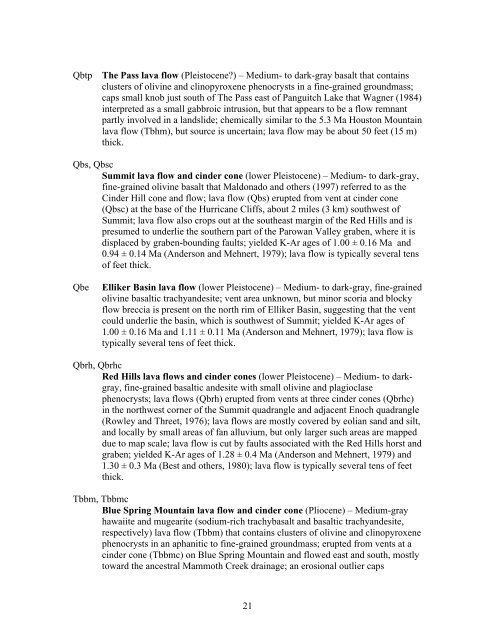Interim Geologic Map of the West Part of - Utah Geological Survey
Interim Geologic Map of the West Part of - Utah Geological Survey
Interim Geologic Map of the West Part of - Utah Geological Survey
You also want an ePaper? Increase the reach of your titles
YUMPU automatically turns print PDFs into web optimized ePapers that Google loves.
Qbtp The Pass lava flow (Pleistocene?) – Medium- to dark-gray basalt that containsclusters <strong>of</strong> olivine and clinopyroxene phenocrysts in a fine-grained groundmass;caps small knob just south <strong>of</strong> The Pass east <strong>of</strong> Panguitch Lake that Wagner (1984)interpreted as a small gabbroic intrusion, but that appears to be a flow remnantpartly involved in a landslide; chemically similar to <strong>the</strong> 5.3 Ma Houston Mountainlava flow (Tbhm), but source is uncertain; lava flow may be about 50 feet (15 m)thick.Qbs, QbscSummit lava flow and cinder cone (lower Pleistocene) – Medium- to dark-gray,fine-grained olivine basalt that Maldonado and o<strong>the</strong>rs (1997) referred to as <strong>the</strong>Cinder Hill cone and flow; lava flow (Qbs) erupted from vent at cinder cone(Qbsc) at <strong>the</strong> base <strong>of</strong> <strong>the</strong> Hurricane Cliffs, about 2 miles (3 km) southwest <strong>of</strong>Summit; lava flow also crops out at <strong>the</strong> sou<strong>the</strong>ast margin <strong>of</strong> <strong>the</strong> Red Hills and ispresumed to underlie <strong>the</strong> sou<strong>the</strong>rn part <strong>of</strong> <strong>the</strong> Parowan Valley graben, where it isdisplaced by graben-bounding faults; yielded K-Ar ages <strong>of</strong> 1.00 ± 0.16 Ma and0.94 ± 0.14 Ma (Anderson and Mehnert, 1979); lava flow is typically several tens<strong>of</strong> feet thick.QbeElliker Basin lava flow (lower Pleistocene) – Medium- to dark-gray, fine-grainedolivine basaltic trachyandesite; vent area unknown, but minor scoria and blockyflow breccia is present on <strong>the</strong> north rim <strong>of</strong> Elliker Basin, suggesting that <strong>the</strong> ventcould underlie <strong>the</strong> basin, which is southwest <strong>of</strong> Summit; yielded K-Ar ages <strong>of</strong>1.00 ± 0.16 Ma and 1.11 ± 0.11 Ma (Anderson and Mehnert, 1979); lava flow istypically several tens <strong>of</strong> feet thick.Qbrh, QbrhcRed Hills lava flows and cinder cones (lower Pleistocene) – Medium- to darkgray,fine-grained basaltic andesite with small olivine and plagioclasephenocrysts; lava flows (Qbrh) erupted from vents at three cinder cones (Qbrhc)in <strong>the</strong> northwest corner <strong>of</strong> <strong>the</strong> Summit quadrangle and adjacent Enoch quadrangle(Rowley and Threet, 1976); lava flows are mostly covered by eolian sand and silt,and locally by small areas <strong>of</strong> fan alluvium, but only larger such areas are mappeddue to map scale; lava flow is cut by faults associated with <strong>the</strong> Red Hills horst andgraben; yielded K-Ar ages <strong>of</strong> 1.28 ± 0.4 Ma (Anderson and Mehnert, 1979) and1.30 ± 0.3 Ma (Best and o<strong>the</strong>rs, 1980); lava flow is typically several tens <strong>of</strong> feetthick.Tbbm, TbbmcBlue Spring Mountain lava flow and cinder cone (Pliocene) – Medium-grayhawaiite and mugearite (sodium-rich trachybasalt and basaltic trachyandesite,respectively) lava flow (Tbbm) that contains clusters <strong>of</strong> olivine and clinopyroxenephenocrysts in an aphanitic to fine-grained groundmass; erupted from vents at acinder cone (Tbbmc) on Blue Spring Mountain and flowed east and south, mostlytoward <strong>the</strong> ancestral Mammoth Creek drainage; an erosional outlier caps21
















